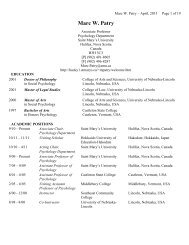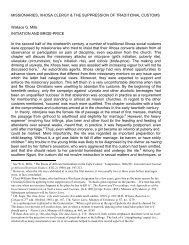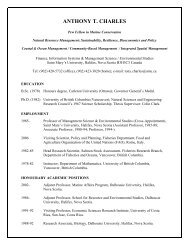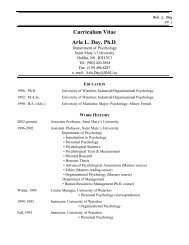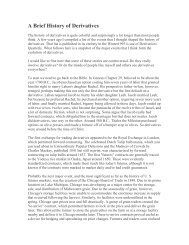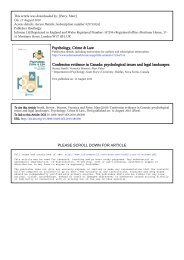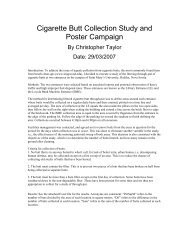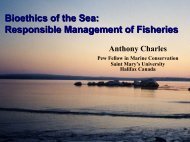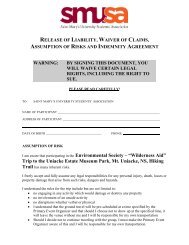Community Fisheries Management Handbook - Saint Mary's University
Community Fisheries Management Handbook - Saint Mary's University
Community Fisheries Management Handbook - Saint Mary's University
You also want an ePaper? Increase the reach of your titles
YUMPU automatically turns print PDFs into web optimized ePapers that Google loves.
access and effort in the fishery. This handbook should be of relevance to<br />
fish harvesters (fishermen), community groups, First Nations, aboriginal<br />
organizations, fisheries managers, government managers, scientists, and<br />
many others.<br />
Indeed, within the above context, many local organizations are creating<br />
a space for more community-based approaches to fisheries management.<br />
However doing community-based fisheries management in these situations<br />
is very different from working in less regulated, more decentralized<br />
fisheries, such as those that are more common in the South (developing<br />
countries). While the underlying principles and values that guide community-based<br />
management are similar whether in India or in Maine, the onthe-ground<br />
application may be completely different due to the differing<br />
local context.<br />
A further key feature of this handbook is its grounding in the particular<br />
fisheries of what we refer to as ‘the Atlantic Region’ – the Atlantic coast<br />
of Canada and of New England in the United States. All case studies and<br />
examples of community-based fisheries management are drawn from<br />
that region, and largely from the inshore fisheries of four jurisdictions<br />
– Nova Scotia, New Brunswick, Maine and Massachusetts. Indeed, the<br />
handbook’s regular use of this rich collection of real-world examples is<br />
fundamental to what is provided here – by drawing on the insights and<br />
lessons of these concrete examples, those engaged in community-based<br />
fisheries management both in the Atlantic Region and elsewhere in the<br />
world will be able to obtain ideas and approaches that may be relevant to<br />
their own local context.<br />
The handbook is for those who need basic, concise ‘how-to’ information<br />
about the many different aspects and approaches of community-based<br />
fisheries management. As community-based management cannot be considered<br />
an easy process, the handbook is for those looking for ideas to help<br />
them address the challenges and complexities involved.<br />
[A note on words: In the first paragraph of this section, you will see the<br />
terms ‘fisherman’ and ‘fish harvester’ appearing together. These two terms<br />
for someone who goes fishing (along with another, ‘fisher’, which is not<br />
used here) are all found often in English language writings on fisheries,<br />
with the choice among them depending on the author and the type of publication.<br />
In this <strong>Handbook</strong>, we have avoided choosing a single term, but<br />
instead have used the two terms ‘fisherman’ and ‘fish harvester’ (or simply<br />
‘harvester’) interchangeably throughout. In reading the handbook, one<br />
must simply keep in mind that these terms are used here with exactly the<br />
same meaning.]<br />
Using the <strong>Handbook</strong><br />
The handbook is divided into three major parts as follows:<br />
Part 1: <strong>Community</strong>-based <strong>Fisheries</strong> <strong>Management</strong> (CBM)<br />
Part 1 provides an introduction to the general ideas behind communitybased<br />
fisheries management, and gives a general overview of communitybased<br />
fisheries management within three sections on “Basic Concepts”,<br />
“Setting the Context” and “<strong>Fisheries</strong> Managers”.<br />
Part 2: <strong>Management</strong> Activities in <strong>Community</strong>-Based <strong>Fisheries</strong> <strong>Management</strong><br />
Part 2 is the core of the handbook. It can be used as a stand-alone reference<br />
on the “how to” of specific fisheries management activities. It is divided<br />
into ten chapters, each covering a key community-based fisheries management<br />
activity. The intent is to provide the information and approaches that<br />
community fishery practitioners need to do their work. Thus, each chapter<br />
has a brief introduction and some key points, often in bullet form, plus real<br />
life experiences presented in text boxes. Part 2 can be used as a reference<br />
guide as needed, with the chapters written in such a way that they can be<br />
read in any order. Readers can go directly to any chapter to learn more<br />
about that particular topic, or how to approach a particular management<br />
activity. A Resources section at the end of each chapter lists other useful<br />
materials for each topic.<br />
C O M M U N I T Y F I S H E R I E S M A N AG E M E N T H A N D B O O K



